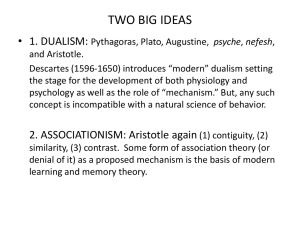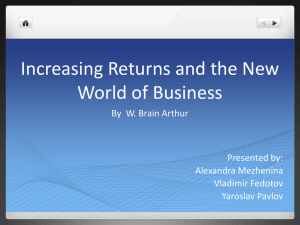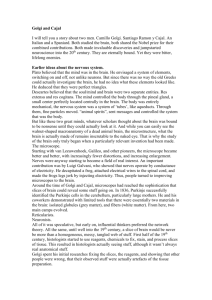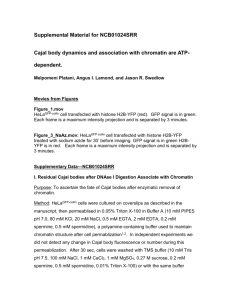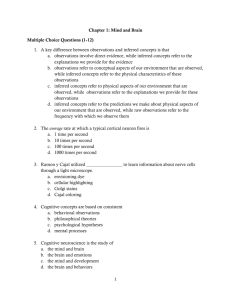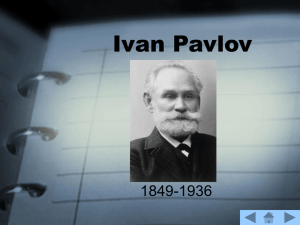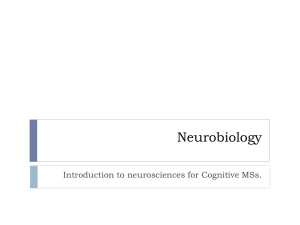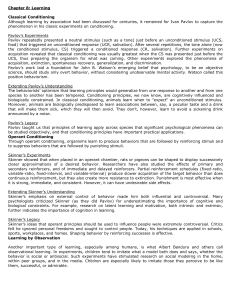Neuron Doctrine and Conditional Reflexes at the XIV International
advertisement
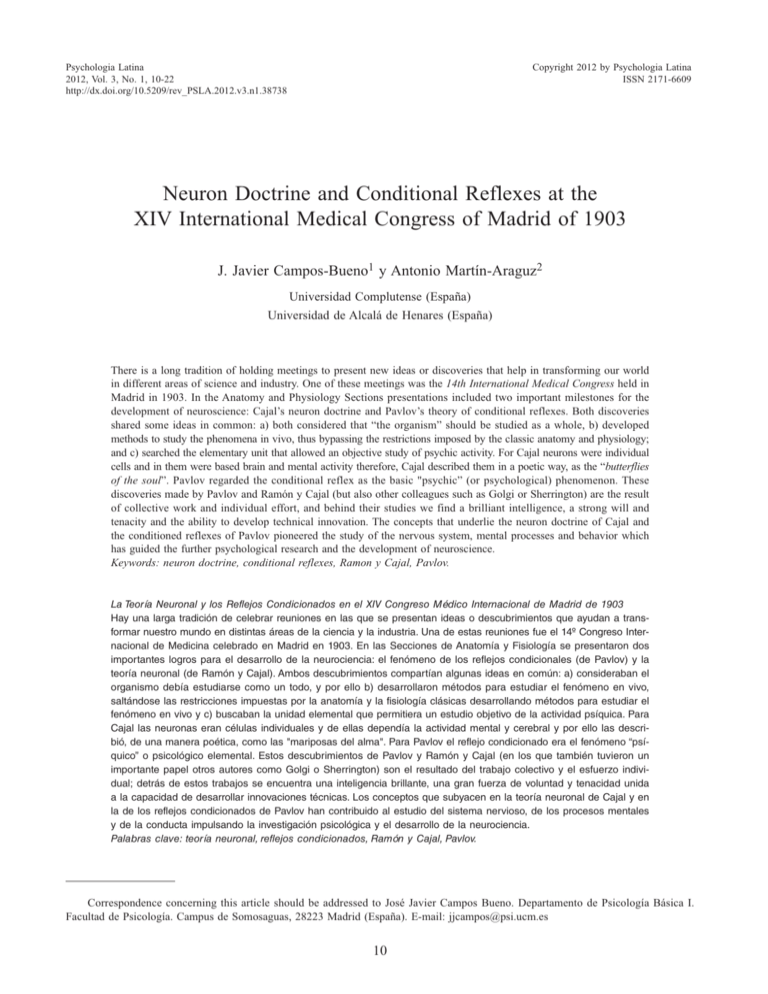
Psychologia Latina 2012, Vol. 3, No. 1, 10-22 http://dx.doi.org/10.5209/rev_PSLA.2012.v3.n1.38738 Copyright 2012 by Psychologia Latina ISSN 2171-6609 Neuron Doctrine and Conditional Reflexes at the XIV International Medical Congress of Madrid of 1903 J. Javier Campos-Bueno1 y Antonio Martín-Araguz2 Universidad Complutense (España) Universidad de Alcalá de Henares (España) There is a long tradition of holding meetings to present new ideas or discoveries that help in transforming our world in different areas of science and industry. One of these meetings was the 14th International Medical Congress held in Madrid in 1903. In the Anatomy and Physiology Sections presentations included two important milestones for the development of neuroscience: Cajal’s neuron doctrine and Pavlov’s theory of conditional reflexes. Both discoveries shared some ideas in common: a) both considered that “the organism” should be studied as a whole, b) developed methods to study the phenomena in vivo, thus bypassing the restrictions imposed by the classic anatomy and physiology; and c) searched the elementary unit that allowed an objective study of psychic activity. For Cajal neurons were individual cells and in them were based brain and mental activity therefore, Cajal described them in a poetic way, as the “butterflies of the soul”. Pavlov regarded the conditional reflex as the basic "psychic” (or psychological) phenomenon. These discoveries made by Pavlov and Ramón y Cajal (but also other colleagues such as Golgi or Sherrington) are the result of collective work and individual effort, and behind their studies we find a brilliant intelligence, a strong will and tenacity and the ability to develop technical innovation. The concepts that underlie the neuron doctrine of Cajal and the conditioned reflexes of Pavlov pioneered the study of the nervous system, mental processes and behavior which has guided the further psychological research and the development of neuroscience. Keywords: neuron doctrine, conditional reflexes, Ramon y Cajal, Pavlov. La Teoría Neuronal y los Reflejos Condicionados en el XIV Congreso Médico Internacional de Madrid de 1903 Hay una larga tradición de celebrar reuniones en las que se presentan ideas o descubrimientos que ayudan a transformar nuestro mundo en distintas áreas de la ciencia y la industria. Una de estas reuniones fue el 14º Congreso Internacional de Medicina celebrado en Madrid en 1903. En las Secciones de Anatomía y Fisiología se presentaron dos importantes logros para el desarrollo de la neurociencia: el fenómeno de los reflejos condicionales (de Pavlov) y la teoría neuronal (de Ramón y Cajal). Ambos descubrimientos compartían algunas ideas en común: a) consideraban el organismo debía estudiarse como un todo, y por ello b) desarrollaron métodos para estudiar el fenómeno en vivo, saltándose las restricciones impuestas por la anatomía y la fisiología clásicas desarrollando métodos para estudiar el fenómeno en vivo y c) buscaban la unidad elemental que permitiera un estudio objetivo de la actividad psíquica. Para Cajal las neuronas eran células individuales y de ellas dependía la actividad mental y cerebral y por ello las describió, de una manera poética, como las "mariposas del alma". Para Pavlov el reflejo condicionado era el fenómeno “psíquico” o psicológico elemental. Estos descubrimientos de Pavlov y Ramón y Cajal (en los que también tuvieron un importante papel otros autores como Golgi o Sherrington) son el resultado del trabajo colectivo y el esfuerzo individual; detrás de estos trabajos se encuentra una inteligencia brillante, una gran fuerza de voluntad y tenacidad unida a la capacidad de desarrollar innovaciones técnicas. Los conceptos que subyacen en la teoría neuronal de Cajal y en la de los reflejos condicionados de Pavlov han contribuido al estudio del sistema nervioso, de los procesos mentales y de la conducta impulsando la investigación psicológica y el desarrollo de la neurociencia. Palabras clave: teoría neuronal, reflejos condicionados, Ramón y Cajal, Pavlov. Correspondence concerning this article should be addressed to José Javier Campos Bueno. Departamento de Psicología Básica I. Facultad de Psicología. Campus de Somosaguas, 28223 Madrid (España). E-mail: jjcampos@psi.ucm.es 10 NEURON DOCTRINE AND CONDITIONAL REFLEXES Scientific meetings that changed the World? A mid-nineteenth century began to be held scientific meetings and Universal Expositions in order to present new ideas, scientific discoveries, advances in engineering or recent inventions that contribute to the wellbeing of individuals and the welfare of society. The contributions made in some of these meetings have proved to be decisive in the transformation of our world in different fields (Houghton, 2008). The International Congresses of Medicine formed part of this tradition, which began in Paris in 1867. The new knowledge and inventions presented in these scientists and industrialists forums were very numerous and competing with each other simultaneously. Faced with such an abundance of discoveries and inventions was not always easy to realize its importance, at least in a widespread manner. However, the passage of time has allowed us to see that some of those discoveries were going to be particularly useful for the development of science and social progress. One of these meetings of interest was the 14th International Medical Congress held in Madrid in 1903. In this conference were presented, at a wide audience, two notable findings that influenced the development of neuroscience. Ramón y Cajal actively participated as President of the Section of Anatomy. He also defended the presentation of one of these finding and another important finding was provided and defended by Ivan P. Pavlov. It was important for Spain to host this International Congress. Spain was a nation recently battered by the loss of her last overseas colonies, Cuba and the Philippines, after a brief war with the United States of America. This war affected many Spanish intellectuals of the era, including Cajal, who when invited to visit Clark University in 1899 considered declining the invitation. After the war declared by the U.S. against Spain an anti-American sentiment was widespread in the national press. Nevertheless, Cajal wanted to maintain a good scientific relation with their American colleagues and he was interested in showing their research not only in Europe but also overseas. Therefore, Cajal accepted the invitation (Ramón y Cajal 1899, Ramón y Cajal, 1937/1923). Soon after this trip of Cajal to the United States, the International Medical Congress of Paris of 1900 took place. Then Madrid was chosen, for the first time, as the venue for the next International Medical Congress. Spanish doctors, Cajal among them, took the challenge with enthusiasm showing to the medical world the level of Spanish science in brain microanatomie. Cajal was very active in organizing the Congress of Madrid in 1903. Without doubt, Cajal was the most internationally known host and during the opening session of the Anatomy Section he highlighted the social importance of this Congress with the following words: “The modest Spanish science that begins to revive welcomes you with enthusiasm, because we know that these major scientific meetings produce an invaluable source of benefits ... We therefore hope that your savant advice and 11 the example of your laboriosité will push strongly the evolution of medical science Spanish, allowing us in the future to take a more active part in the sublime and peaceful fight in the development of civilization”. (Original in French:“La modeste science espagnole qui commence à renaître vous accueille avec enthousiasme, car elle n’ignore point que ces grandes réunions scientifiques sont pour elle la source de bénéfices inestimables… Nous espérons donc que vos savants conseils et l’exemple de votre laboriosité pousseront vivement l’évolution de la science médicale espagnole, en lui permettant dans l’avenir de prendre une part des plus actives dans la lutte pacifique et sublime de la civilisation.” (Ramón y Cajal,1904a). The Madrid 1903 meeting, in addition to the social impact which had for Spanish society, also had great academic relevance that was not sufficiently remembered when a century later, in 2003, it was held the 150 th anniversary of the birth of Ramón y Cajal. Then appeared several publications, which they put the Spanish scientist among the founders of neuroscience and they recognized the great influence that he had on its development (De Felipe, 2002; Sotelo, 2003; Llinás,2003). However, this sexquicentenary of Cajal’s birth coincided with another important event because also a century had passed from the XIV International Medical Congress of 1903, but that fact had gone quite unnoticed. Nevertheless, from an historical perspective this international meeting had a special significance because there came forward two key achievements for the development of neuroscience. What happened in that Congress? Those days by sheer coincidence of time and place, Ramon Cajal defended the neuron doctrine before a large audience and Pavlov explained his theory of conditional reflexes. International Medical Congresses A hundred years ago, the International Medical Congresses were not only important events for the academic community but also represented an event of cultural and social relevance. London, Copenhagen, Berlin, Washington, Vienna, Rome, Geneva, Moscow or Paris were the cities that had host the meetings for a week. These Medical Congresses were capable of bringing together some thousand doctors and, therefore, were not only a large scientific meeting but also constituted a cultural and social event of the first order. Kings and Presidents of the host nations presided over the opening ceremonies and there were organized institutional events. Newspapers and magazines devoted front pages and columns highlighting the activities of the participants (Fig. 1). Why governments showed such interest and enthusiasm in those meetings? In the heyday of positivism it was well known that the most advanced knowledge of their time in medical sciences had important consequences for the individual and social well-being. It was necessary to support 12 CAMPOS-BUENO Y MARTÍN-ARAGUZ Figure 1. The 1903 Congress in Madrid was widely covered by the press. The Pawlow (sic) and Ramón y Cajal lectures were announced in Madrid newspapers. Here, as appeared in A) El Correo Español, April 28, 1903, evening edition; and B) La Ilustración Europea y Americana, 30 Abril, 1903. One of the headquarters of Congress, in the Palace of Museums and Library (now Archeological Museum and National Library) these meetings at the same time that emerged a new style of research, conducted by German Universities (Shepherd, 1991). Therefore, there were built up laboratories and it were instituted awards for researchers. The Czar Nicolas II established one of those prestigious awards in August 1897, when he announced the City of Moscow prize, which carried a huge sum of money, during the Russian convention of the XII Congress. The prize would be awarded to the most original research submitted in successive Congresses of Medicine and the first edition of the prize took place three years later in Paris. Pavlov, a prestigious physiologist who had not participated as a member of the Russian scientific committee in the Moscow Congress, attended the Paris meeting and wanted to get the award. The Paris meeting was important for the academic life of Pavlov and Cajal. Why it was so important for both Russian and Spanish researcher? Because both competed for the Moscu Prize although they had no opportunity to meet each other in Paris. In fact, Cajal did not even attend the Paris Congress held in August 1900. Following his visit to the United States, Cajal’s health left much to be desired attacked by neurasthenia, with palpitations, cardiac irregularities and insomnia resulting in mental depression during the entire fall and winter. For this reason, looking recover his health Cajal chose to stay that summer in their modest Amaniel’s cottage in Madrid at Almansa Street, near the Quatro Caminos(Ramón y Cajal,1937/1923). However, Cajal from Madrid and Pavlov from Saint Petersburg were contenders for the coveted City of Moscow prize. A third academic, Metschnikoff from Paris, was also proposed as a candidate. Cajal won the first edition of the Czar prize, obtaining 14 votes in his favor against 6 for Metschnikoff and 3 for Pavlov. Moreover, and this was relevant to Cajal and for Spain, because at the same session it was decided that the next Congress of 1903 will be held in Madrid (Attribution du Prix du Moscou, 1900). It was in Madrid where Metschnikoff won the second edition of the award. Pavlov, at that time in Paris, was also contender for the Nobel prestigious price, that had been recently established. And Science magazine, that regularly reported their readers of those Congresses, gave also details of modern physiological investigation carried on the physiology of secretion by Pavlov. He was introduced as a “brilliant Russian investigator” and announced that “the publication, last year, of the conditions which are to govern the award of the Nobel prizes was followed not long since by the announcement that Professor J. P. Pawlow of St. Petersburg had been designated, with Professor Niels R. Finsen of Copenhagen, as the first recipient of this honor, for the most important discovery in the department of physiology or of medicine” (Mendel, 1901). Robert Tigerstedt, Professor of Physiology in Stockholm and member of the Karolinska Institutet, who in 1897 had been president of the International Congress of Medicine in Moscow (Silverman, 2002), supported Pavlov’s nominee (Todes, 1997) but the firsts recipients of the Prize were von Behring in 1901 and Ross in 1902, followed by Finsen who won the Prize in 1903. The Pavlov’s lectures on digestive glands had already appeared in Russian collected in a single book that shortly after their stay in Paris was translated into German and English (Pavlov, 1897,1902; Dewsbury, 1997, Davenport 2004). Nowadays Pavlov was already a prestigious researcher and therefore he had been acting in the Congress of Paris as President of the “Physiologie, Physique et Chimie Biologiques” Section in the morning of 8 of August. By the NEURON DOCTRINE AND CONDITIONAL REFLEXES news of the time, we know that he gave the lecture in French “Experimental Therapy based on a new and useful technique of Physiological Studies“ although the Proceedings of the Physiology Section do not collect this work of Pavlov (Gley, 1900) and it happened again, three years later, with his conference on conditional reflexes that never would be published in the Proceedings of the Madrid Congress. At the Paris conference, he suggested the utility of an “experimental therapy“ based on physiology, which can be successful in developing a scientific work using its specific physiological resources. His work on the physiology of reflexes, Pavlov says, in essence, is fully consistent with the modus operandi of medicine in the treatment of patients (Klimenko and Golikov, 2003). Nevertheless, until the turn of the century, Pavlov had not been done systematic experiments on conditioned reflexes. The Pavlov’s Lab papers written by his collaborators Wolfson and Snarki talked only about “psychic influence” on digestion. At that time, Pavlov described the “psychic influence” in terms of psychic excitation, psychic effect, psychic secretion or psychic juice. Pavlov had not yet conducted systematic studies of conditioning, but he was not convinced that the psychic phenomena should be explained in merely subjective terms. In 1901, Pavlov was certain that a physiological approach “would allow the fruitful development of brain physiology which would explore the role of the brain in organizing the interactions between the organism and its environment” Therefore, Pavlov started the experimental study on conditioned reflexes that was carried out in his Department by Tolotchinov. This new research by Pavlov, trying to discover the reflex mechanisms of psychic activity, transformed old Sechenov’s ideas into a theory, which could be proven experimentally (Klimenko and Golikov, 2003). The first results were presented by Tolochinov in a local Congress of Northern Naturalists and Physicians held in Helsingfors in 1902, a few months before Pavlov’s trip to Madrid (Tolochinov, 1903). As mentioned above, Pavlov had been selected as a candidate for the Nobel Prize; therefore, he mobilized his whole laboratory of St. Petersburg to present as many papers as possible at the Helsinki Congress of Naturalist and Physicians knowing that his friend Tigerstedt, the famous discoverer of rennin, and other members of the Nobel Committee would be present. The result was a mélange of papers that did little to promote Pavlov’s candidature producing, by the contrary, an unfavorable impression on the Pavlov Laboratory’s venture into a new territory. Pavlov’s own paper was on the identity of pepsin and rennet, a topic in the science of biochemistry Pavlov knew nothing about (Todes, 2002). Even some members of the Committee asked themselves if Pavlov really was the man who was guiding the research in his lab. Therefore Pavlov, after the Helsinki meeting and possibly thinking about his candidacy for the Nobel Prize, changed his mind on how he should present their work. In fact, the topic selected by 13 Pavlov for the Madrid Congress lecture was indeed very different. Pavlov decided to discuss at the Congress of Medicine in 1903 the conditioned reflexes theory and it was a world premiere. Madrid 1903: Ramón y Cajal and Pavlov The Worldwide Medical Congress of 1903 attracted to the capital of Spain about seven thousand doctors, of which nearly half were Spanish and the rest of scholars came from abroad. These classical researches on brain cells, on conditional reflexes or other topics presented in the Medical Congresses, were presented mainly in French and occasionally in German or English or in the local language. But the original published papers had been written in a variety of languages such as German, Italian, French, English or Russian. Therefore, participate in these global conferences allowed the researchers to disseminate their research in a shared language. The Madrid Congress bestowed to the scientific activities scheduled international recognition in the press, as in previous Congresses. Their activities also made headlines in scientific journals (Fig. 2).The country had been out of the core of the scientific research for a long time, but now had the opportunity to receive international recognition for its recovery in the field of science. Ramón y Cajal and Pavlov, two distinguished researchers from Spain and Russia, were internationally known when they presented their findings to the scientific community at the Madrid event (Campos, 2003; Frixione, 2009; García-Albea, 2010). Their studies shared some common ideas because viewing the organism Figure 2. The 1903 Medical Congress was well covered by the Science magazine, but their correspondent in Madrid informed that no relevant discoveries were presented though the programs had announced “many papers of importance”. 14 CAMPOS-BUENO Y MARTÍN-ARAGUZ Figure 3. Although the terms “butterflies of the soul” and “psychic reflex”must be understood in a metaphoric sense both tems have continued to appear in the texts over a century. Here is shown the evolution of the number of citations of the terms in English and Spanish, from 1900 until today (Google tool reference in Bohannon, J. (2010). Google Opens Books to New Cultural Studies. Science, 330, 1600). NEURON DOCTRINE AND CONDITIONAL REFLEXES as a whole surpassed the restrictions imposed by the classic anatomy. Moreover, following the dictum of an era in which “technology is everything” both scholars developed new fruitful methods, in particular, a technique that allowed observing dogs salivating “in vivo” through a permanent fistula or, in the other case, the staining of neurons “in vivo” using the method of Simarro. Second, both discoveries emphasized the importance of contiguity as a functional property of the brain. Finally, as a crucial element of his theory, these two researchers were trying to find an elementary unit that would allow an objective study of mental activity. For Pavlov this unit was the conditioned reflex, which should be regarded as a psychological phenomenon that he originally called -in a metaphorical sense- “psychic reflex”. For Cajal nerve cells, or neurons, were the mental unit and were described, in a poetic way, as the “butterflies of the soul” (figure 3). Ramón y Cajal was a well-known researcher for over a decade since he had his lucky encounter with Kölliker in Berlin during the Congress of the German Anatomical Society in 1889. In 1894, he delivered the Croonian Lecture (La fine structure des centres nerveux) on the texture of the nervous system invited by Michael Foster, by then secretary of the Royal Society, following a suggestion of Charles Sherrington (Ramon y Cajal, 1894; Jones, 1994). Cajal presented his findings concerning the structure and connections of nerve cells in the spinal cord, olfactory bulb and retina. Therefore, expecting that the main interest of the audience were, like Sherrington, the architecture of spinal reflexes Cajal started by the spinal cord and in his drawings illustrated that each nerve cell consists of three parts (cell body, protoplasmatic prolongations and axis cylinder) each with distinct functions for reception, transmission and distribution following a “dynamic orientation” (Shepherd, 1991). Five years later, the great psychologist Stanley Hall, President of Clark University invited five European scientists to participate in the Decennial Celebration of Clark University. Among them was Ramon y Cajal who presented still unpublished studies on the human cerebral cortex (Ramón y Cajal, 1937/1923). The conference was a great event that the local press picked it up with headlines like “Exotic tongues speak wisely“ or “Prof. Cajal among speakers“ (Haines, 2007). This trip to America was quite a recognition to the work that Cajal had done after their discovery of the Golgi method in 1887 in the laboratory of Dr. Simarro. From that moment began a frenzied investigation for five years that bore fruit to the neuron doctrine. Six decades of discoveries were ending in a coherent theory of nerve cells. The race had started in 1833, when Ehrenberg discovered the nerve fibers, and in the same era Remak, Wagner, Hemholtz and Hanover observed multipolar cells with ramified expansions and believed that these expansions were continuous with nerve fibers. In 1865, Deiters make the first clear distinction in all nerve cells between two kinds of expansions what were called dendrites in 1890 by His, and axons in 1896 by Kölliker and, and the 15 same time, Gerlach developed the ideas of Deiters and served as a basis for the insterstitial protoplasmatic Golgi network (Shepherd, 1991). Schlieden in 1838 and Schwann in 1839 had proposed that the cell was the functional unit of all living things and it constituted the basic organizing principle in biology. The Cell Theory was soon well established during the following years as the basic principle of organization in most organs of the body. However, it was not believed to apply to the nervous system and the acceptance of this principle in the nervous system was delayed because was very difficult to visualize the structure of the nervous cell under the microscope (Shepherd, 2009). The method of chromate of silver discovered by Camillo Golgi in 1873 finally enabled the examination of the finer structure of the gray matter allowing the visualization of individual cells in the central nervous system (Golgi, 1975). This Golgi method let the silver nitrate react with pieces of brain hardened in potassium dichromate and Golgi thought that the new reaction allowed demonstrating the structure of the interstitial stroma of the cerebral cortex. A battle started between the so-called neuronist and reticularist (Shepherd, 1991; Clarke & Jacyna, 1987; Finger, 1994). When Golgi studied the hippocampal and cerebellar tissue with his new staining technique, he reasserts his belief that the nervous system consists of a reticulum because there were so many connections between the nerve cells. For reticularists axis cylinder is fused by anastomosis connecting cell body or protoplasmatic prolongations. In line with this reasoning, some researchers such Golgi or Gerlach, thought that gray matter was formed by a continuous diffuse nerve network and therefore a law for transmission between nerve cells could not be formulated (Golgi, 1884/ 1995). Cajal’s works, along with the studies of others colleagues (Golgi, Kölliker, His, Lenhossek, Retzius,etc.) written in various European languages, were thoroughly reviewed in a series of six papers published by Waldeyer in 1891. Those new findings were summarized in a coherent theory, which concluded that specific types of nervous system cells, called neurons or nerve cells, constitute the anatomical, physiological, metabolic and genetic unit of the nervous system (Waldeyer, 1891; Shepherd, 1991). Shortly after, the introduction of the concept of synapse in 1897 by Sherrington and Foster provided an anatomical and functional explanation of the mechanism that allows nerve cells to communicate (Sherrington, 1897) as had been described by Cajal in the law of dynamic polarization. However, despite his talent for inferring from morphological data the existence of synapses and the one-way property of neural data transmission Cajal was not able to realize the intraneuronal reversibility that Sherrington prove experimentally (Berlucchi, 1999). By 1900 the neuron doctrine was fairly acceptance, after several comprehensive reviews of the work of Golgi, Cajal, Kölliker, His, Forel, Retzius, van Gehuchten, among others. However, Golgi persisted in defending their idea because, like Cajal, both were not only interested in knowing how 16 CAMPOS-BUENO Y MARTÍN-ARAGUZ Figure 4. After being introduced by his “dear friend Luis Simarro” in the Golgi staining technique Ramón y Cajal popularized the method in the following years. (Ramón y Cajal, S. Gaceta Sanitaria Municipal, 1890). B) Simarro in 1900 published the silver bromide technique –later modified by Cajal- that provided clear evidence in favor of the neuron doctrine. (Reproduced, with permission, from the Universidad Complutense, Legado Luis Simarro, Fundación General). the nature of the nerve cell was, but also wanted to know how these cell populations could mediate brain functions. Therefore, Golgi still considered that nerve fibers and their branches form a complex network that was the solution to the problem of the neural basis of the brain functions (Shepherd, 1991). How Cajal raised the presentation of their research at the Congress in Madrid? Cajal had four communications. One of them, on 28 April, was an invited lecture on the structure of the optic thalamus (Ramón y Cajal, 1904b). The press release of the time described that the work was much applauded by the audience that filled the room and interrupted the presentation of the paper in French acclaiming the speaker constantly. We know that half of the nearly seven thousand registered doctors were Spanish and quite possibly would those compatriots, in most cases, responsible for the warm reception given to that conference. No doubt, Cajal was a very popular savant in Spain, judging by the comments appeared in the newspapers (Campos, 2006). However, the work to discuss here is the one that was presented that day at the meeting of the Section of Anatomy. Why do insist Cajal on that defense of the neuron theory, apparently well established by that time? With no doubt, it is due to Golgi insistence in considering that the fibers of nerve cells formed a complex brain network and therefore the reticular theory still was a valid attempt to understand the neural basis of brain function. The Golgi’s reticular model claimed that the nerve cells and their extensions form a continuous protoplasmic network allowing the nervous currents to flow freely in all directions. Nevertheless, Cajal’s observations supported that nerve cells are individual units being the axon in close contact with dendrites, without fusing. The propagation of nerve impulse goes always from the dendrites through the cell body and into the axon, a principle that was called by neuronist the “law of dynamic polarization”. However, Gerlach, who has died in 1896, had proposed a third model based on the nature and function of neurofibrils which forced Cajal to fight a second battle in defense of the neuron doctrine (Campos, 2003; Frixione 2009). The neurofibrils model proposed that nerve cells could indeed be individual units, although the actual conducting system would nevertheless be a continuous network constituted by neurofibrils threaded through cells, axons, dendrites, and even across the extracellular space (Frixione 2009). To defend neuronal theory Cajal, faced with a large audience of foreign savants, probably more specialized than the congregated in the auditorium of San Carlos, presented in the Laboratory for Biological Research a paper modestly described by him of “little interest“ and “of a polemical nature concerned [with] the venturesome reticular theories of A. Bethe ... In it I attempted particulary - says Cajal- to promote and enliven the discussion on the important problem of interneuronal connections and the minute structure of the nervous protoplasm, questions at that time of vital interest (Ramón y Cajal, 1937/1923). In this controversial paper entitled “Criticism of A. Bethe theory concerning the structure and connections of nerve cells”(Ramón y Cajal,1904c). In the original paper, that was presented in French but later translated into Spanish, Cajal argued against the reticular theory and against the idea that the nervous system was a widespread continuous network formed by filaments. In the debate that followed his presentation Simarro, another great Spanish NEURON DOCTRINE AND CONDITIONAL REFLEXES histologist, invited by Cajal, spoke at length supporting the neuron doctrine with his own data and showing excellent preparations of the neuro-fibrillar net impregnated by his own original method. Simarro had devised a new technique (Simarro, 1900; Campos, 2006), using a silver impregnation procedure, later called Cajal’s reduced silver method which was more reliable in staining neurofibrils and allowed a clear visualization of protoplasm (Fig. 3). It has been said that the Cajal method’s were only modifications of the photographic process of Simarro but the criticisms is unjust. Cajal’s method owes Simarro the conception of the technique but, as Brontë Gatenby and Cowdrey pointed, Cajal continued improving them adding new formulae . Therefore it can be considered a new method, although “both are based on the silver-reducing power of certain photographic reagents” (Ramón y Cajal, 1903, 1904d; 1904e; Brontë Gatenby & Cowdrey, 1928). The selective staining of the neuronal cytoskeleton made originally by Simarro revealed that the neurofibrils did not form a continuous neuronal network. Bethe’s theory wanted to recover “the forgotten theory of Gerlach, with the difference that in this new one the ends of dendrites are directly involved in the network, while in the former Bethe theory the neurofibrils or elementary fibers of protoplasm are those that constitute are interstitial or intercellular net”. However, with the preparations made using the method of Simarro “the fibrils do appear smooth or slightly granular ...are gathered in bundles and always are absolutely confined within the cell, and never are seen leaving the soma or dendrites, to get lost in the interstitial gray matter”. During the session, Cajal and Simarro exhibited “many choice preparations showing the structure of spinal cord, the cerebrum and the cerebellum”. Cajal attempted to persuade their audience about “the absolutely objective nature of [his] interpretations concerning the method of termination of the nerve fibers in the gray matter.“ (Fig. 4). In the light of new evidence provided in this Congress Cajal enthusiastically stated: “[the reticularists] write to attack the independence of neurons, without evidence or new facts… At the door of this highly original and audacious histology, the motto of Dante’s hell should be written: ‘Lasciate ogni speranza’. You … must know you are following a chimera. This contrived house of cards, … this panreticularism, that is trying to substitute the brilliant neuronal theory and the connection between neurons by contact, rests on pure supposition incapable of resisting a simple criticism … The Golgi network … is absolutely unobservable” (Ramón y Cajal, 1904c). Three years later Golgi was still refusing the neuron doctrine (Shepherd, 1991). At the Nobel Prize ceremony he attempted, in his discourse, “to refloat his almost forgotten theory of insterstitial nerve nets... -and in Cajal own words... defending his extravagant lucubration ... he made a display of pride and self-worship so immoderate that they produced a deplorable effect upon the assembly”. The attitude of Golgi determined to discrediting the neuron doctrine displeased Cajal that expected the “cordial eulogy ... which was 17 Figure 5. Original drawing by Ramon y Cajal done to criticize the theory of A. Bethe on the structure and connections of nerve cells. The drawing shows some nerve cells of the rabbit spinal cord the stained “in vivo” using the method of Simarro: A) cell, cut lengthwise; B) neuron sectioned tangential; C) another cut through; D) small funicular cell; a) fibrillar surface layer; b) bundles that go from one dendrite to another; c) perinuclear fibrillar layer; d) chromatic holes and threads that intersect; e) section of a thick dendrite. Ramón y Cajal S. (1904c). imperiously required by justice and by courtesy” (Ramón y Cajal, 1937/1923) but nonetheless he praised the work of Golgi at the discourse of the next day ceremony. Still, three decades later, Cajal published a long paper against reticularism aiming to defend the claim of neuron theory on the anatomical unity of nerve cells (Ramón y Cajal, 1933, 1954). The controversy was finally settled when, with the help of electron microscope, it was demonstrated the existence of the synapse (Palade and Palay, 1954) . It was also in the Congress of Madrid where Pavlov 28 April gave an invited lecture on “The Experimental Psychology and Psychopathology of Animals”. He introduced his recent studies on reflexes showing that the conditioned reflex was a psychological phenomenon that could be studied experimentally (Pavlov, 1903/1955). At the end of the lecture Pavlov shared his skills with others physiologist (Wedensky and Vartanoff from Saint Petersburg, Barbieri and Vaschide from París, and Stewart from Chicago, and Potenciano, Pérez Zúñiga, Lavín, Torremocha and Pi Sunyer from Spain) in 18 CAMPOS-BUENO Y MARTÍN-ARAGUZ the laboratory of Gomez Ocaña who also was a skilled surgeon with dogs. The Proceedings of the Congress reported that both techniques employed during that clinic session were successful but the animal vagotomized with the Gomez Ocaña technique survived for longer than the Pavlov’s dog (Gómez Ocaña, 1904). At the end of the Nineteentn Century the concept of reflex activity, and its background of sensorimotor physiology, had received great attention by the physiologist. Marshall Hall coined the term “reflex” in 1883 (Hall, 1883). The introduction of the noun “reflex”, like Waldeyer’s name neuron for nervous cell, was simple but extremely important. It gave a new perspective for automatic actions described by Descartes in his Tractatus Homine (1662) and other outstanding physiologists (v.gr. Willis, Whytt and Procháska) which studied the spinal reflex. The essential contribution of Hall to reflex physiology was that he moved away “from the nebulous notions of soul and other inmaterial principles and toward an explanation for reflex action based on anatomy and the unique functions of the spinal cord”. However, Hall still denied all possibility of reflexes operating by way of the brain but Hall’s works were acclaimed abroad Britain, especially in Germany and France. Müller shared Hall’s idea that the components of the reflex arc are sensation, motion and volition. However, Müller thought that volition “could be in the brain as well as in the spinal cord, whereas Hall permitted only the cord and medulla oblongata to take part in reflex action” (Clarke & Jacyna, 1987). In a very short time, the Hall’s theories on the reflex concept were the subject of numerous researches resulting in the development of the concept of “cerebral reflexes” and the foundation of two schools of neurophysiology: the Pavlovian, in Russia, and the Sherringtonian, in the West. The reflex was seen as a unitary concept of the nervous function. As Clarke and Jacyna point out: “on this view the reflex cannot be confined to one limited portion of the nervous system…; it must have applications throughout the cerebrospinal axis, up to including the cerebrum. It follows that mental function cannot be excluded from the scope of reflex theory, but must be seen as a further mode of reflex action”. This idea, that it is imperative to understand the functioning of the reflex to study how the nervous system works, encouraged the work of Sherrington, on the side of the physiologists and, on the other hand, the work of Russians experimental psychologists represented by Pavlov, spezialized in physiology, (Clarke & Jacyna, 1987; Lerner, Margolin, & Witztum, 2005) and, of course, by Bekhterev who was specialized in neurology, psychiatry and experimental and clinical psychology (Bekhterev, 1933). Both were Professors in Saint Petersburg, at the Military Medical Academy, and Bekhterev was director of the clinic for mental and nervous illnesses. Bekhterev studies on reflexology were performed studying human subjects defensive responses to electrical stimulation applied on the limb extremities. When studying defensive reflexes, Bekhterev used the term “associative reflex”, which was (as he himself said) simply another name for the more familiar ‘conditioned reflex’, the term used in Pavlov’s laboratory” studies” (Bekhterev, 1928) on appetitive conditioning. The lives of Pavlov and Bekhterev ran parallel, and they felt appreciation to each other. However, their friendship was seriously affected when they argued bitterly about the functions of the brain and they stopped talking to one another. Pavlov and Bekhterev were prominent Russian scientists and both contributed to the study of conditional reflexes but the role of Bekhterev remains relatively unknown after suffering a violent death. Before the Russian revolution he was prosecuted by his political ideas. Nevertheless, under the soviets rule it was even worse and he died in tragic circumstances. It is thought that the secret police poisoned Bekhterev because, shortly before, he had examined Stalin and diagnosed him as paranoid. After his death his name was not mentioned in the USSR until Stalin’s death in 1953 and Bekhterev’s works were not republished until 1980s (Lerner, Margolin, & Witztum, 2005). Resuming again the work of Pavlov, we can ask what was Pavlov’s contribution to the study of reflexes in the Congress in Madrid? Pavlov gave a remarkable lecture, as relevant as that presented by Cajal. As we have already seen, Cajal had defended in 1903 his paper on neuron doctrine, presented at the Anatomy Section, in front of an audience gathered in his laboratory located near San Carlos Hospital. It was his second and definitive battle against the reticularism then hidden under a new model supported on the neurofibrils. The same day that Cajal defended the neuron doctrine, Pavlov, as participant in the Physiology Section, also had to defend there, in the Amphitheater of San Carlos Hospital, his theory of learning by conditioning. Therefore, in April 2003 a session took place in Madrid to commemorate the centenary of Pavlov’s theory and the guests were Mackintosh (2003), Rescorla (2003), Boakes (2003) and Klimenko (Klimenko & Golikov , 2003) among other specialists in neurosciences, animal learning and conditioning (see the 2003, vol. 2, of The Spanish Journal of Psychology). The chosen venue was the Great Amphitheatre in San Carlos in the old School of Medicine in Madrid, where Pavlov and Cajal gave their lectures a century ago. The event was a deserved recognition for Pavlov research who gave the world the first public exposition in French of his theory on conditional and unconditional reflexes in front numerous worldwide scientists. We know that in Madrid Pavlov started his lecture as follows: “Regarding the language of facts as most eloquent, I shall take the liberty of proceeding directly to the experimental material, which gives me the right to speak on the subject of my present communication. To begin with, this is the story of the transition of the physiologist from research into purely physiological problems to the sphere of phenomena usually called psychical. Although this transition took place suddenly, it occurred in a perfect natural way and what seems to me most important in this NEURON DOCTRINE AND CONDITIONAL REFLEXES respect, without changing, so to speak, methodological front” (Pavlov, 1903/1955). Pavlov emphasized that he was obliged to investigate psychical facts if he wanted to make a thorough study of physiology of digestion. Pavlov selected for their Madrid lecture only experiments with salivary glands, although apparently the salivary glands play a minor physiological role in the study of reflexes. However, Pavlov stated that he was “convinced that they will become classical objects for the new type of research about which I shall have the honor of telling you today”. For Pavlov the, so-called, “psychic” experiences, which he was studying in his laboratory, had their cause in the general mechanism of reflex. The external properties (light, sound or smell) of the object –Pavlov argued- should have no relevance to the salivary gland function, nor should have any influence over them. However, in the “psychic experiences” these properties of objects, and everything surrounding those objects, played an exciting role when are related with food or acid. The apparent inconsistency of psychic experience was due only “to a higher number of conditions that influences over the result of a psychic experience compared to the physiological experience. This is a conditional reflex.“ Pavlov recognized the importance of his discovery. In his own words, he was fully persuaded “that a boundless field of fruitful research opens before us… it is another and immense part of the physiology of the nervous system, a system which mainly establishes the correlation not between the separate parts of the organism, our main subject so far, but between the organism and the surroundings” (Pavlov, 1903/1955). In fact, the three main protocols of learning described by Pavlov: habituation, sensitization and classical conditioning opened a fruitful path for neuroscientist. Shortly afterwards Cajal and Pavlov obtained the highest academic recognition of his career for their discoveries that had been presented to a large audience at the International Medical Congress. Both researchers, when they presented the results of their work in Madrid, were clearly aware that such findings significantly would affect the further development of their disciplines and, therefore, both gave an emphatic speech in front of his qualified colleagues. Next year, in 1904, Pavlov was laureated with the Nobel Prize in Physiology or Medicine “in recognition of his work on the physiology of digestion, through which knowledge on vital aspects of the subject has been transformed and enlarged”. But Pavlov, going far from his recognition of his work on the physiology of digestion, in his Nobel Lecture, entitled “Physiology of Digestion”, expressed, as he had done in Madrid 1903 Congress his “deep conviction that in this direction,- the search of neuronal mechanisms of learning and memory through conditioning-, physiological research can advance greatly and successfully. (Wood , 2004). Two years later, Ramon y Cajal was also awarded by the Swedish Academy “in recognition of their work on the structure of the nervous system“. In his Nobel Lecture, 19 The Structure and Connexions of Neurons, Ramón y Cajal confronted with Golgi his own research into the individuality of neurons and the transmission of nerve impulse across the synapse (López-Muñoz, Boya, & Alamo, 2006). Those classical studies of Pavlov and Cajal were a landmark in brain research, and paved the way for modern neuroscience. Eric Kandel gives us a good example, in his memoirs, of how Cajal and Pavlov guided their research (Kandel, 2007). At the beginning of the 1960s Kandel wanted to study the cellular mechanism of learning using a reductionist approach to the biology of learning and memory and the Aplysia was a suitable experimental animal for such research. Aplysia had only a small number of large and accessible nerve cells that would reveal if the mechanism of memory storage had been conserved in phylogeny. It was known, since Cajal era, that certain sets of neurons were very adaptable and plastic, and perhaps neurons could be permanently altered because of synaptic changes that should last for long periods and even stay for a lifetime when learning occurs. How can be studied the cellular mechanism of learning wondered Kandel? Ramon y Cajal had proposed the principle of connection specificity, “according to which, during development, a neuron will form connections only with certain neurons and not with others… and I saw in the circuitry of the gill-withdrawal reflex of Aplysia this remarkable regularity of connections that Cajal referred to and we saw, in exquisite detail, that specific identified cells made invariant connections to one another. But this invariant organization of neurons posed deep questions. How could we reconcile hardwired circuits in the nervous system and the specificity of connections with the animal’s capability for learning? Once acquired, where or how is learned information retained in the nervous system?” (Kandel, 2007) Ramón y Cajal – Kandel says- proposed a solution in the conclusions of his Croonian Lecture: “... it can be assumed as something very likely that mental exercise facilitates a greater development of the protoplasmic apparatus and of the nervous collaterals in the part of the brain in use. In this way, pre-existing connections between groups of cells could be reinforced by multiplication of the terminal branches of protoplasmic appendices and nervous collaterals“ (Ramon y Cajal, 1894). Cajal conceived learning as a single process that modifies the synaptic strength of connections between neurons. However, Pavlov, Konorski, Milner or Kimble studies on conditioning and learning showed that there were many different ways of learning induced by different combinations of stimuli. Such protocols generate two very different types of memories: short-term memory and long-term memory. Kandel thought that the great success of Pavlov creating learning by conditioning was due to the simple patterns of sensory stimulation used. Those stimuli triggered activation patterns highly suitable for the production of long-term changes in synaptic transmission. Therefore, Kandel transformed the idea of Cajal and assumed that there are different 20 CAMPOS-BUENO Y MARTÍN-ARAGUZ ways of learning that have specific characteristics of neural activity. It can be expected that memory is stored if these changes are persistent. Kandel realized “that the paradigms of simple learning articulated by Pavlov … included precise protocols for stimulating experimental animals. It occurred to me that the paradigms they described - habituation, sensitization, classical conditioning, and operant conditioning - could readily be adapted to experiments with an isolated Aplysia ganglion using artificial electrical rather than natural sensory stimuli” that can be used as neural analogs of learning. “While recording the behavior of a single cell in a ganglion, one nerve axon pathway to the ganglion could be stimulated weakly electrically as a conditioned stimulus, while another pathway was stimulated as an unconditioned stimulus, following the exact protocol used for classical conditioning with natural stimuli in intact animals” (Kandel, 2000). Having on mind those Pavlov and Ramon y Cajal ideas, Kandel conducted excellent research, on biology of attention and learning based on the molecular analysis of short-term and long-term memory storage processes and the neural representation of space in the hippocampus Today neuroscientists are faced with different challenges from those faced their predecessors but their research is an example for modern neuroscientists. Behind these discoveries made by Golgi, Ramón y Cajal, Sherrington or Pavlov, which are the result of collective work and individual effort, we find the ability of technical innovation, a brilliant intelligence and a strong will and tenacity. The concepts that underlie the neuron doctrine of Cajal, and the conditioned reflexes of Pavlov, opened a fruitful path, although sometimes controversial, for the study of the nervous system, mental processes and behaviour through search of the synaptic mechanisms of learning and memory, which has guided the psychological research and the development of neuroscience in the twentieth century (Shepherd, 1991; 2010). References Attribution du Prix du Moscou (1900). Proccès-verbal de la deuxième reunion, pour l’attribution du Prix du Moscou, tenue a la Faculté de Médecine de Paris, le 8 Août 1900. Retrieved from http://www.ucm.es/bucm/med/Moscu-7.pdf Bekhterev V. M. (1928). Avtobiografiya (Postmertnaya) [Autobiography (Posthumous)]. In Biblioteka “Ogonyok”. Moscow, Russia: Pravda. Bechterev V. M. (1933). General principles of human reflexology: An introduction to the objective study of personality. London, England: Jarrolds Publishers. Berlucchi G. (1999). Some aspects of the history of the law of dynamic polarization of the neuron. From William James to Sherrington, from Cajal and Van Gehuchten to Golgi. Journal of the History of the Neurosciences, 8(2), 191-201. http://dx.doi. org/10.1076/jhin.8.2.191.1844 Boakes R. (2003). The impact of Pavlov on the psychology of learning in English-speaking countries. The Spanish Journal of Psychology, 6, 93-98. Brontë Gatenby J., & Cowdrey E. V. (1928). Bolles Lee’s microtomist’s vade-mecum (9th Ed., pp. 563-570). London, England: Churchill. Campos J. J. (2003). Ideas para un siglo: De la teoría de la neurona a los reflejos condicionados. Revista de Historia de la Psicología, 25, 725-730. Campos J. J. (2006). Un día en el Arco de Santa María. In A. Ferrús & A. Gamundí (Eds.), Santiago Ramón y Cajal, 100 años después (pp.62-92). Madrid, Spain: Editorial Pirámide. Clarke E., & Jacyna L. S. (1987). Nineteenth-century origins of neuroscientific concepts. Berkeley, CA: University of California. Davenport H. W. (2004). Pavlov’s physiology factory: A physiologist as entrepreneur an essay review. Journal of the History of Medicine and Allied Sciences, 59, 273-289. http://dx. doi.org/10.1093/jhmas/jrh069 De Felipe J. (2002). Sesquicentenary of the birthday of Santiago Ramón y Cajal, the father of modern neuroscience. Trends in Neurosciences, 25, 481-484. Dewsbury D. A. (1997). In celebration of the centennial of Ivan P. Pavlov’s (1897/1902). The work of the digestive glands. American Psychologist, 52, 933-935. http://dx.doi.org/10.1037/ /0003-066X.52.9.933 Finger S. (1994). Origin of neuroscience. A history of explorations into brain function. New York, NY: Oxford University Press. Frixione E. (2009). Cajal’s second great battle for the neuron doctrine: The nature and function of neurofibrils. Brain Research Reviews, 59, 393-409. http://dx.doi.org/10.1016/j.brain resrev.2008.11.002 García-Albea E. (2010). El auge Mundial de las neurociencias: XIV Congreso Internacional de Medicina, (Madrid 1903). Revista de Neurología, 50, 551-557. Gley M. (1900). Comptes rendus: XIII Congrès International de Mèdecine: Publiés sous la direction de A. Chauffard. Section de physiologie, physique et chimie biologiques. Paris, France: Masson et Cie. Golgi C. (1995). Sulla fina anatomia degli organi centrali del sistema nervoso. Firenze, Italy: Giunti Editore. (Orig. 1884). Golgi C. (1975). Sulla struttura della grigia del cervello. Gazetta Medica Italiani Lombardi, 6, 244-246. Translated by M. Santini as “On the structure of the gray matter of the brain”, In M. Santini (Ed), Golgi Centennial Symposium, Proceedings (pp. 647-650). New York, NY: Raven Press. Gómez Ocaña J. (1904). Survie d’un chien après la double section simultanée des deux nerfs vague-sympathique, pratiqué dans le cou. In A. Fernández-Caro (Ed.), XIVe Congrès International de Médecine. Madrid 23-30 Abril 1903: Comptes Rendus. Section de Physiologie (Physique et Chemie Biologiques) Mr. Juan Manuel Diaz Villar (pp. 132-138). Madrid, Spain: J. Sastre y Cia. Haines D. E. (2007). Santiago Ramón y Cajal at Clark University, 1899; his only visit to the United States. Brain Research Reviews, 55, 463-480. http://dx.doi.org/10.1016/j.brainresrev. 2007.02.002 NEURON DOCTRINE AND CONDITIONAL REFLEXES Hall M. (1833). On the reflex function of the medulla oblongata and the medulla spinalis. Philosophical Transactions of the Royal Society B: Biological Sciences, 123, 635-665. http://dx. doi.org/10.1098/rstl.1833.0028 Houghton J. (2008). Meetings that changed the world: Madrid 1995: Diagnosing climate change. Nature, 455, 737-738. http://dx.doi.org/10.1038/455737a Jones E. G. (1994). Santiago Ramón y Cajal and the Croonian Lecture, March 1894. Trends in Neurosciences, 17(5), 190192. http://dx.doi.org/10.1016/0166-2236(94)90100-7 Kandel E. (2000). Autobiography. Nobelprize.org. Retrieved from http://www.nobelprize.org/nobel_prizes/medicine/laureates/2000/ kandel-autobio.html Kandel E. (2007) In search of memory: The emergence of a new science of mind. New York, NY: W. W. Norton & Company. Klimenko V. M., & Golikov J. P. (2003). The Pavlov department of physiology: A scientific history. The Spanish Journal of Psychology. 6, 112-120. Lerner V., Margolin J., & Witztum E. (2005). Vladimir Bekhterev: His life, his work and the mystery of his death. History of Psychiatry, 16, 217–227. http://dx.doi.org/10.1177/0957154 X05049611 Llinás R. (2003). The contribution of Santiago Ramon y Cajal to functional neuroscience. Nature Reviews Neuroscience, 4, 7780. http://dx.doi.org/10.1038/nrn1011 López-Muñoz F., Boya J., & Alamo C. (2006). Neuron theory, the cornerstone of neuroscience, on the centenary of the Nobel Prize award to Santiago Ramón y Cajal. Brain Research Bulletin, 70, 391-405. http://dx.doi.org/10.1016/j.brainres bull.2006.07.010 Mackintosh N. (2003). Pavlov and associationism. The Spanish Journal of Psychology, 6, 177-184. Mendel L. B. (1901). Professor Pawlow’s researches on the physiology of secretion. Science, 14, 647-649. http://dx.doi.org/ 10.1126/science.14.356.647 Palade G. E., & Palay S. L. (1954). Electron microscope observations of interneuronal and neuromuscular synapses. Anatomical Record, 118, 335–336. Pavlov I. P. (1897). Lektsii o rabote glavnykh pishchevaritelnyteh zhelez [Lectures on the work of the principal digestive glands, in Russian]. St. Petersburg, Russia: Kushneroff. Pavlov I. P. (1902). Lectures on the work of the digestive glands. London, England: Charles Griffin & Co. Pavlov I. P. (1955). Experimental psychology and the psychopathology of animals. Moscu, Russia: Foreing Language Publishing House. (Orig. 1903). Ramon y Cajal S. (1894). The Croonian lecture: La fine structure des centres nerveux. Proceedings of the Royal Society of London, 55, 444-468. http://dx.doi.org/10.1098/rspl.1894. 0063 Ramón y Cajal, S (1899) Comparative study of the sensory areas of the human cortex. In Clark University, 1889-1899, Decennial Celebration (pp. 311-382). Worcester, MA: Clark University. Retrieved from http://cisne.sim.ucm.es/articles/1513567.7693 /1.PDF 21 Ramón y Cajal S. (1903). Méthode nouvelle pour la coloration des neurofibrilles. Comptes Rendus Hebdomadaires des Séances et Mémoires de la Société de Biologie, 36, 1565-1568. Ramón y Cajal, S. (1904a). Seance du 24 avril. In A. FernándezCaro (Ed.), XIVe Congrès International de Médecine. Madrid 23-30 Abril 1903: Comptes Rendus. Section d’Anatomie ((Anthropologie, Anatomie comparée, Embryologie, Anatomie descriptive, Histologie normale et Thératologie) Mr. Dalmacio García Izcara (pp. 3-4). Madrid, Spain: J. Sastre y Cia. Ramón y Cajal S. (1904b). Plan de estructura del tálamo óptico. In A. Fernández-Caro (Ed.), XIVe Congrès International de Médecine. Madrid 23-30 Abril 1903: Comptes Rendus. Volume general (pp. 277-295). Madrid, Spain: J. Sastre y Cia. (Orig. 1903). Ramón y Cajal S. (1904c). Consideraciones críticas sobre la teoría de A. Bethe acerca de la estructura y conexiones de las células nerviosas. In A. Fernández-Caro (Ed.), XIVe Congrès International de Médecine. Madrid 23-30 Abril 1903: Comptes Rendus. Section d’Anatomie (Anthropologie, Anatomie comparée, Embryologie, Anatomie descriptive, Histologie normale et Thératologie) Mr. Dalmacio García Izcara (pp. 6998). Madrid, Spain: J. Sastre y Cia Ramón y Cajal S. (1904d). La méthode à l’argent réduit associée à la method embryonaire pour l’etude des noyaux moteurs et sensitives. Bibliographie Anatomique, 13, 241-275. Ramón y Cajal S. (1904e). Trois modifications pour des usages differents de ma méthode de coloration des neurofibrilles par l’argent réduit. Comptes Rendus Hebdomadaires des Séances et Mémoires de la Société de Biologie, 8, 368-371. Ramón y Cajal S. (1933). ¿Neuronismo o reticularismo? Las pruebas objetivas de la unidad anatómica de las células neviosas. Archivos de Neurobiología. 13, 217-291. Ramón y Cajal, S. (1937) Recollections of my life. Massachusetts, MA: MIT Press. (Orig. 1923). Ramón y Cajal S. (1954). Neuron theory or reticular theory? Objective evidence of the anatomical unity of nerve cells. Madrid, Spain: Consejo Superior de Investigaciones Científicas, Instituto Ramón y Cajal. Rescorla R. (2003). Contemporary study of Pavlovian conditioning. The Spanish Journal of Psychology, 6, 185-195. Shepherd G. (1991). Foundations of the neuron doctrine (pp. 5-7; 244-292). New York, NY: Oxford University Press. Shepherd G. (2009). Neuron doctrine: Historical background. In L. R. Squire (Ed.), Encyclopedia of Neuroscience (Vol. 6, pp. 691-696). New York, NY: Elsevier. Shepherd G. M. (2010). Creating modern neuroscience: The revolutionary 1950s. New York, NY: Oxford University Press. Sherrington C. S. (1897). The central nervous system. In M. A. Foster (Ed.), Textbook of Physiology (7th Ed., Vol. 3). London, England: MacMillan Silverman, B. D. (2002). Robert Tigerstedt: Scientist, educator, social activist, humanitarian. Clinical Cardiology, 25, 399-400. http://dx.doi.org/10.1002/clc.4950250810 Simarro L. (1900). Nuevo método histológico de impregnación por las sales fotográficas de plata. Revista Ibero-Americana de Ciencias Médicas, 4, 332-358. 22 CAMPOS-BUENO Y MARTÍN-ARAGUZ Sotelo C. (2003). Viewing the brain through the master hand of Ramon y Cajal. Nature Reviews Neuroscience,4, 71-77. http://dx.doi.org/10.1038/nrn1010 Todes, D. P. (1997). From the machine to the ghost within: Pavlov’s transition from digestive physiology to conditional reflexes. American Psychologist, 52, 947-955. http://dx.doi.org/10.1037/ /0003-066X.52.9.947 Todes, D. P. (2002). Pavlov’s physiology factory: Experiment, interpretation, laboratory enterprise. Baltimore, MD: Johns Hopkins University Press. Tolochinov I. E. (1903).Contributions à l’étude de la physiologie et de la psychologie des glandes salivaires. Forhändlingar vid Nordiska Naturforskare och Läkaremötet. Helsingfors. Waldeyer W. (1891). Ueber einige neuere forschungen im gebiete der anatomie des centralnervensystems. Deutsche Medicinische Wochenschrift, 17, 1213-1218. http://dx.doi.org/10.1055/s-00291206824 Wood J. D. (2004). The first Nobel Prize for integrated systems physiology: Ivan Petrovich Pavlov, 1904. Physiology, 19, 326330. http://dx.doi.org/10.1152/physiol.00034.2004 Received November 16, 2011 Revision received March 27, 2012 Accepted March 30, 2012
